Olympic National Park 5-day Road Trip Itinerary
Itching for a Pacific Northwest road trip? Get this detailed 6-day Olympic National Park Itinerary filed with tips for the best stops including hikes, campsites, beaches, food & more!
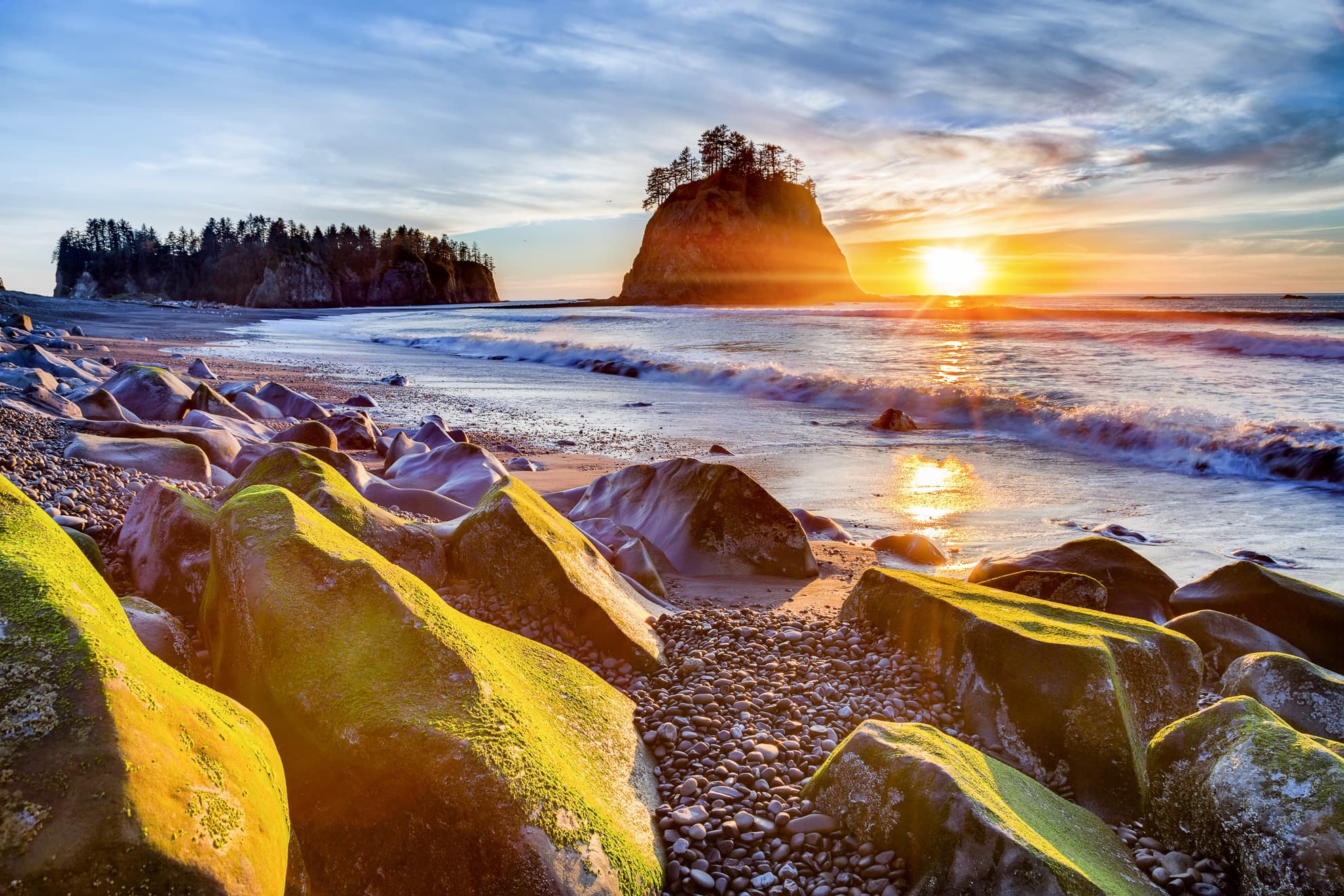
Mountains, ocean, and the rainforest… to most, visiting that such diverse landscapes would involve three separate trips to three very different locations. There is one National Park that has it all though: Olympic National Park, in the northwestern corner of Washington State. And Olympic National Park is beautifully laid out for a perfect 5-day car camping trip that will allow you to experience a lot that the park has to offer.
In this blog post, guest contributor Kim Vawter shares the details of her 5-day Olympic National Park itinerary and her best tips for planning your own road trip.
Plan your road trip with this 5-day Olympic National Park itinerary.
This post may contain affiliate links.
Olympic National Park Basics
First and foremost, you need to be okay with knowing that you aren’t going to see the entire park, not in 5 days at least. My 5-day Olympic National Park road trip itinerary hits all the major highlights, but it would be insane to try to devour the near one million acres of Olympic National Park in a single trip.
The Olympic National Park website is incredibly helpful, and they have posted online information sheets for every single area of the park. Use this link and the menu on the left to select an area of the park to research. I’d also suggest picking up a waterproof copy of National Geographic’s Olympic National Park map.
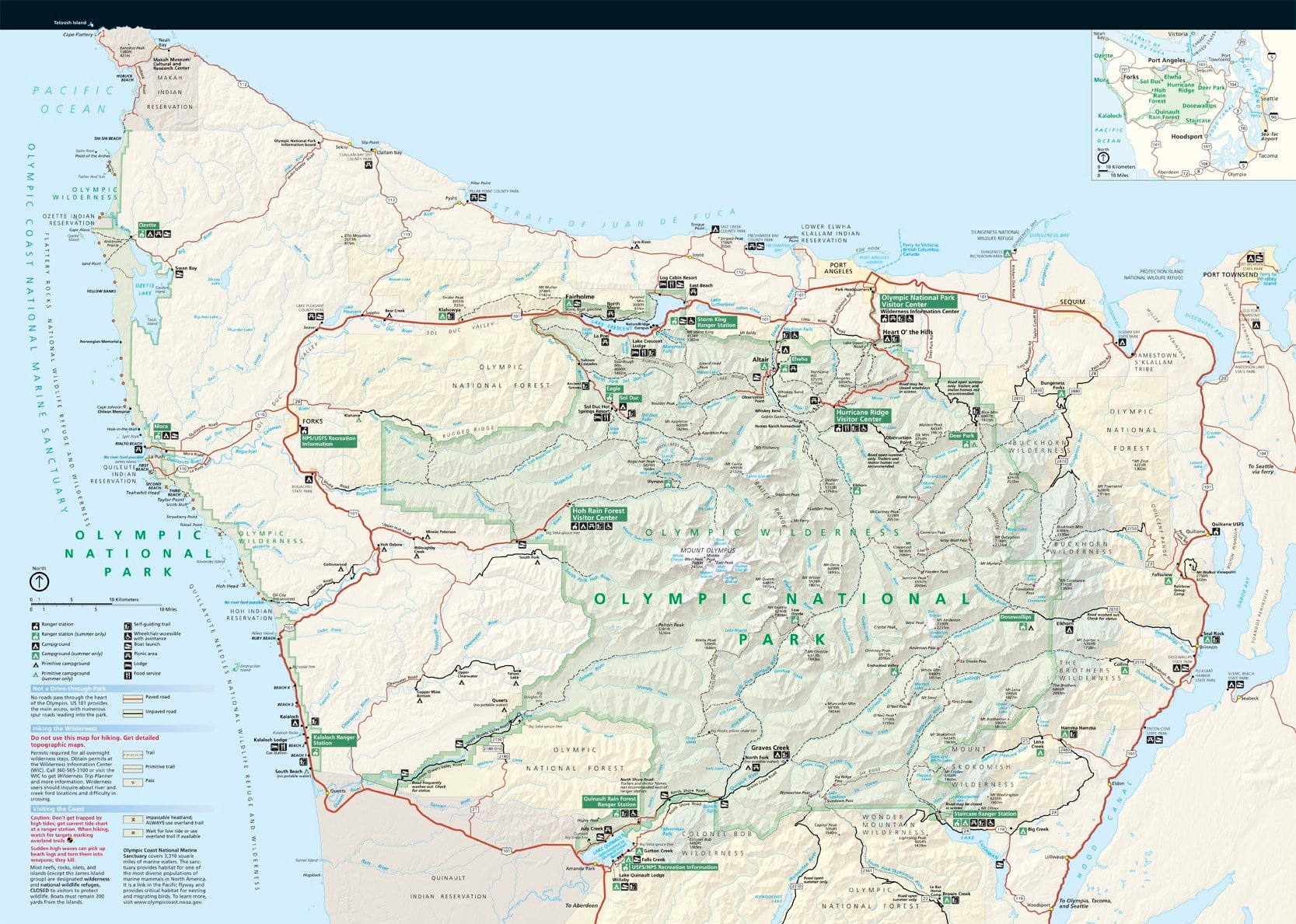
Entrance to Olympic National Park is $20 per vehicle, and your pass will be valid for 7 consecutive days.
Save this post!
Enter your email & I'll send this post to your inbox! You'll also receive my weekly newsletter full of helpful advice for planning your adventures.
Best Time to Visit Olympic National Park
Olympic NP is wet, wet, wet. Even if you go during the summer months, known as the “dry season”, it still may pour! Weather closures, as we learned, aren’t an anomaly for Olympic NP, so check the current park status before you go and plan accordingly. That said, if you are hoping for a dry visit, the summer is your best bet.
Olympic National Park is open year-round, and while some of the roads and facilities do close from October through May, the Hurricane Ridge road is open Friday-Sunday during the winter season for snow activities!
If planning around the weather isn’t your priority, spring offers the best chance of seeing some wildlife – including black bears, elk, and giant banana slugs. It’s also when waterfalls are most impressive and flowers are in bloom.
No matter what season you come, be prepared for rain, then cross your fingers and hope for sunny skies.
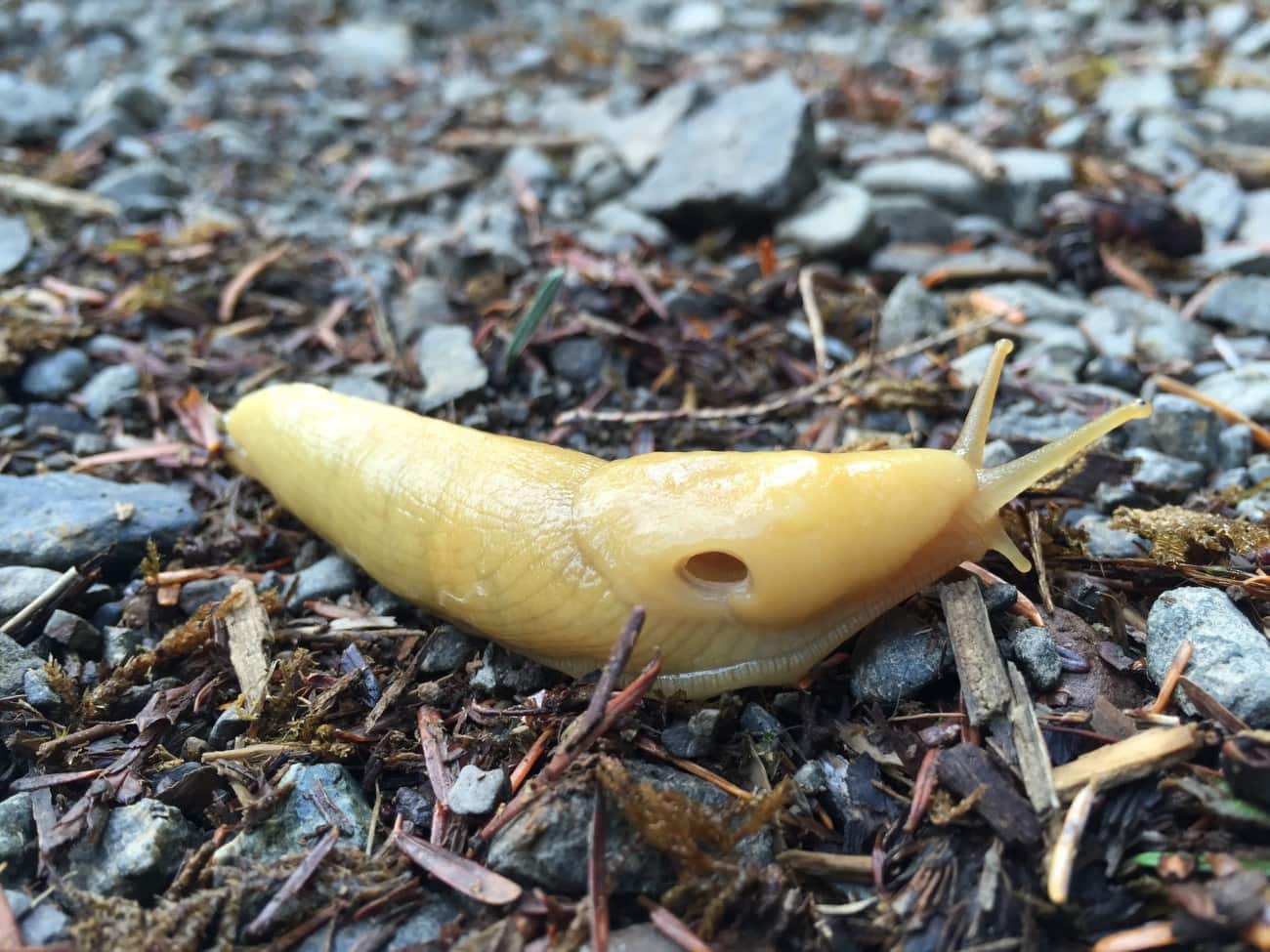
Olympic National Park Permits & Campsites
Car Camping
Olympic National Park boasts beautiful campsites set in peaceful and natural settings. Campsites range from $15-$22 a night, and all but three of them are first-come / first-served.
Kalaloch (a large site on the Pacific Ocean), Sol Duc (a riverside campground tucked in old growth forest), and Mora are the exceptions. These campgrounds accept reservations from June – September and remain first-come / first-served in the off-season.
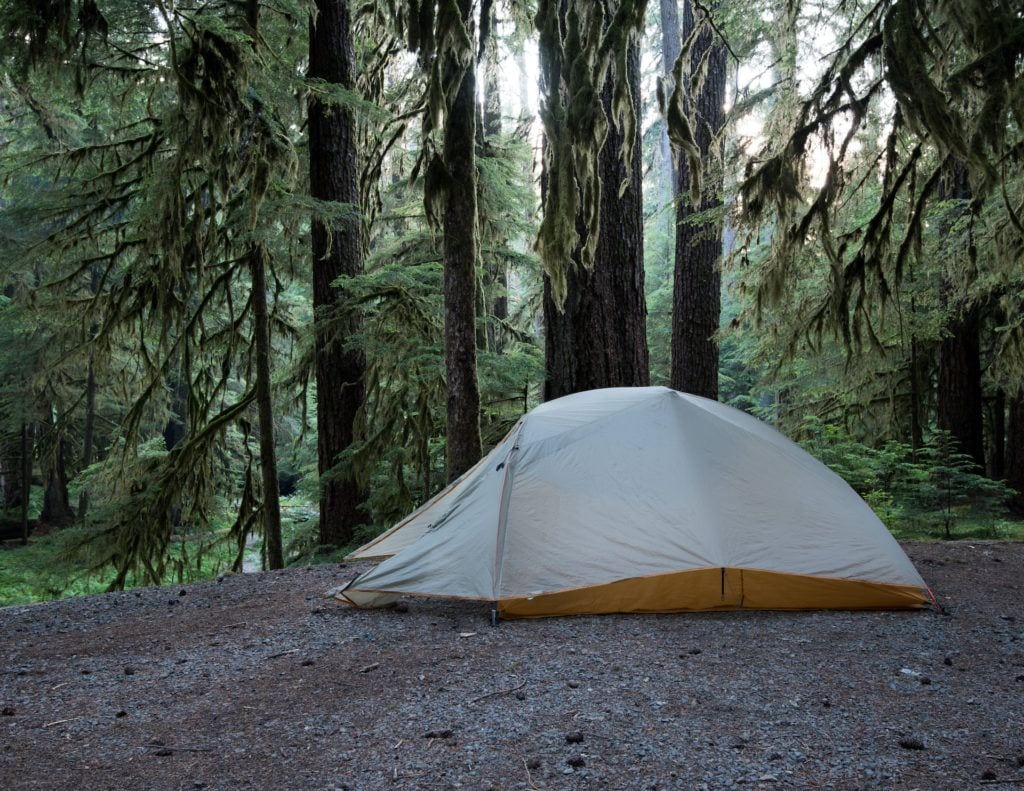
If you are looking for a quiet spot, check out Queets, North Fork Campground, and Deer Park Campground where RVs are not allowed or recommended.
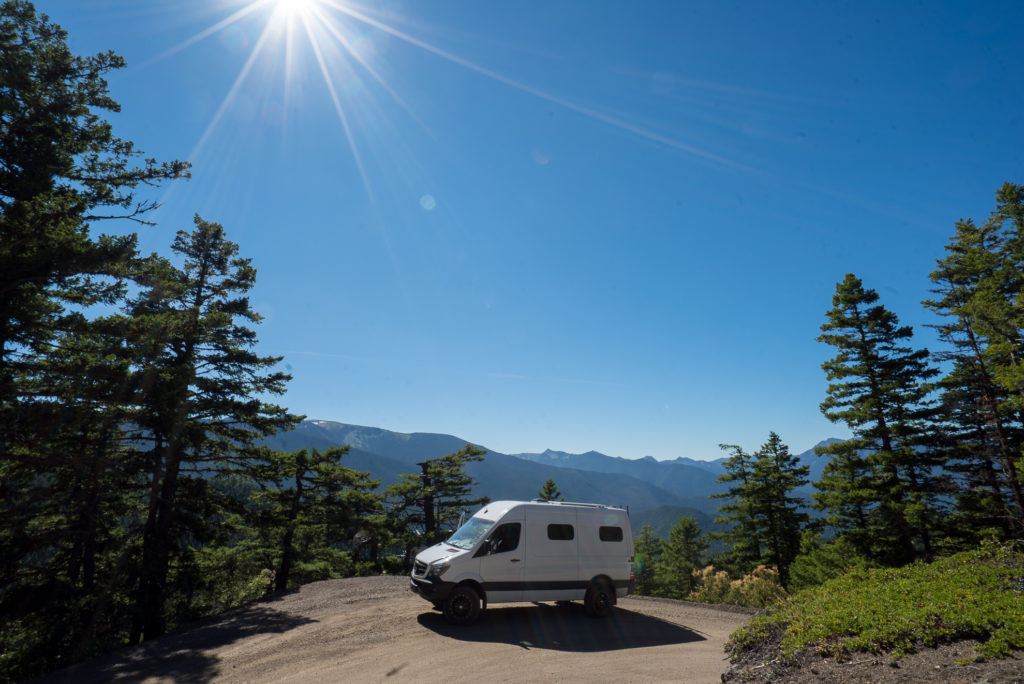
The campground guide on the National Park website also tells you which campgrounds have potable water and flush or pit toilets. And just a heads-up, we couldn’t find a single campsite during our entire trip that had shower facilities.
#1 campsite finder app
Try The Dyrt PRO free for 30 days
Get a FREE 30-Day membership to The Dyrt PRO, one of our favorite apps for finding campsites.
Perks include:
• 5,000+ free camping locations
• 1,000+ campground discount network
• $0 extra booking fees
• Get reservations at sold-out campgrounds, and more
Use the code BEARFOOT to get 30 days free!
Backcountry Camping
If you want to go backpacking in Olympic National Park, you must obtain a wilderness camping permit. They cost $5 per person per night for groups up to 12 people. Depending on the trail, reservations may be required, and the park accepts reservations for the entire season starting on March 15th.
More information on wilderness camping and permit information can be found here.
For one of the best backpacking trips in the Park, check out our writeup on the Olympic National Park High Divide Trail.
Getting to Olympic National Park
While there is public transportation to the park, I think a vehicle is a must for this trip. From the SEA-TAC airport, the Hurricane Ridge Visitor Center (where we started) is just about 3 hours along the I-5 corridor and HWY 101, driving through the towns of Tacoma and Olympia.
If you want to get out on the water, you can also take the ferry from Seattle, crossing the Puget Sound to Bainbridge Island, and the driving north from there towards Port Townsend. One-way rides are about $8, and a regular vehicle costs just $28.
We ended up making a giant loop, which you can see on the Google Map if you keep scrolling down.
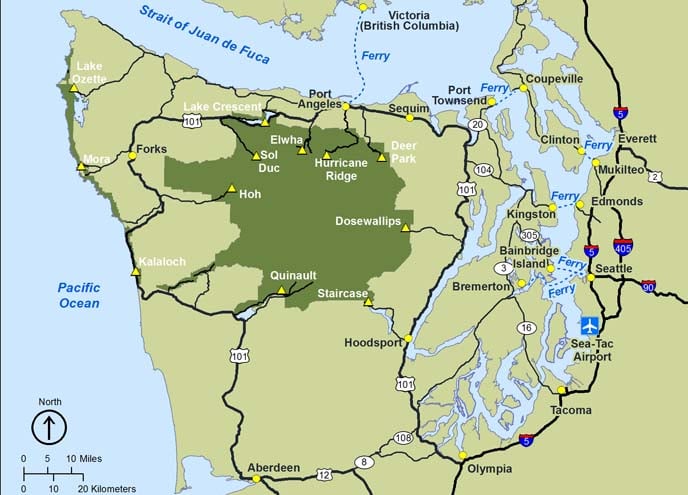
FOODIE TIP: If you take the long route through the town of Olympia, I recommend that you stop at Jay’s Farm Stand as well as the Olympia Co-Op. They both offer a great selection for stocking up on some local products for your trip. If you go through Olympia, you’ll also probably hit the small logging town of Shelton, which has another two awesome foodie stops I have to mention. First is Smoking Mo’s BBQ and then Olympic Mountain Ice Cream.
5 Day Olympic National Park Itinerary
Day 1: Hurricane Ridge
The first day of our Olympic National Park itinerary, we took the ferry and then drove a counterclockwise loop from Seattle. Our first stop on the trip was Hurricane Ridge, where you get panoramic views of Mount Olympus. Here you can hike Hurricane Hill, which is 1.6 miles one way and offers great views of the mountains. There is also an incredible viewing platform at the visitor center.

That first night, we camped at Heart O’ the Hills which was by far one of the most beautiful campsites I have ever visited. I highly recommend loop D that has sites right along a flowing stream.
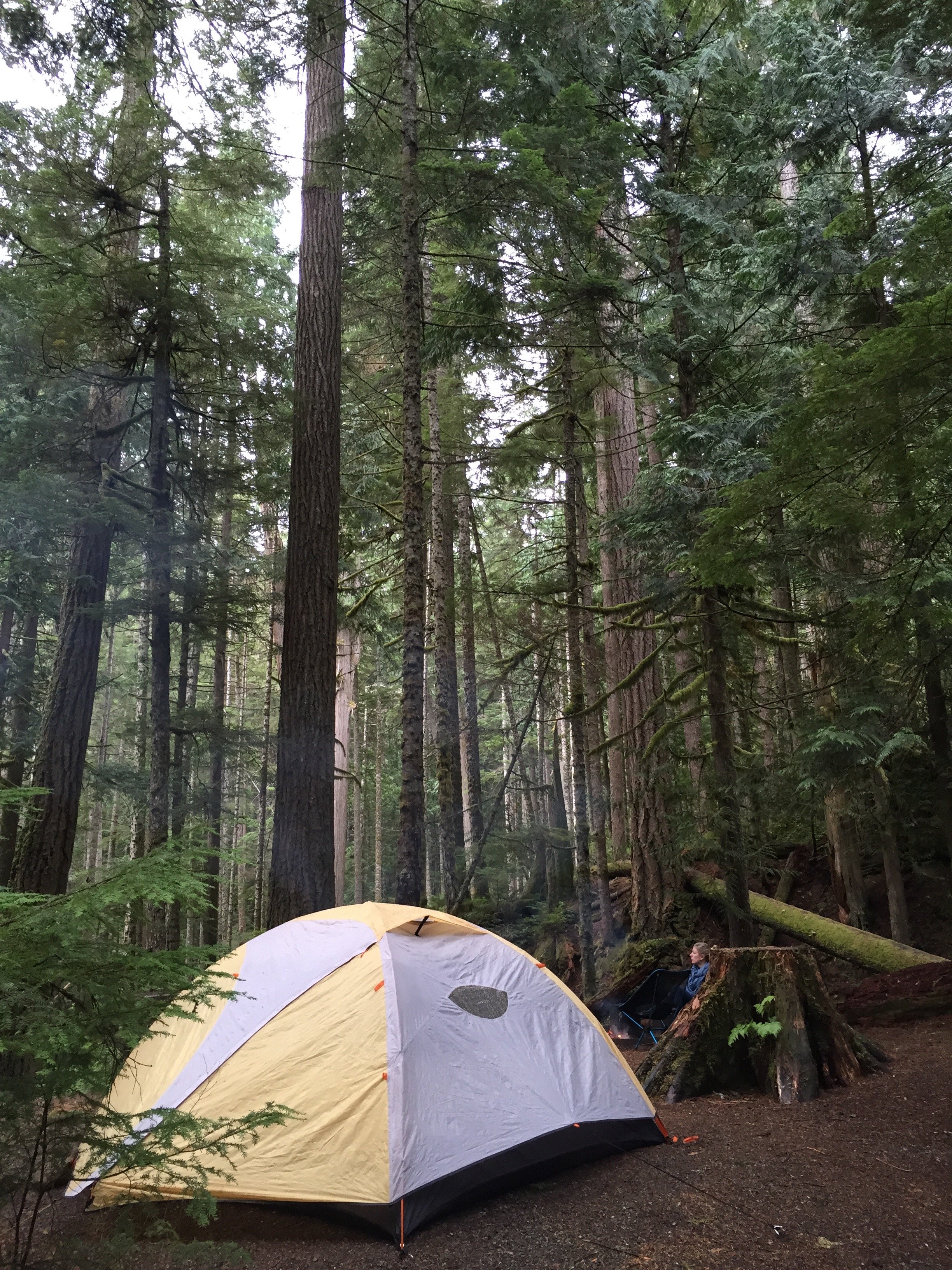
FOODIE TIP: As you are driving in and out of Port Angeles to get between Hurricane Ridge and the rest of the park do not miss the unique natural grocery store called Country Aire Natural Foods. Their fresh deli salads were absolutely delicious.
Day 2: Lake Crescent & Sol Duc Hot Springs
On day 2, get ready for totally different and yet equally incredible landscapes. As you leave the mountains of Hurricane Ridge, you arrive at the 650 foot deep Lake Crescent. Make sure to read up on the Indian legend about how Lake Crescent formed. Geological records suggest there was a large-scale disturbance that affected Lake Crescent and its neighbor, Lake Sutherland – creating two lakes from one.

Lake Crescent also has a delightful lodge on its banks – the Lake Crescent Lodge. The hotel was built in 1915 and includes a stone fireplace and cozy sun porch. The lodge has a beautiful restaurant, bar, and gift shop as well. You can also rent kayaks on the lake to enjoy a beautiful day on the water! They even offer guided kayak tours.
If you want to hike, check out Marymere Falls trail (~1.5 miles round trip) that was as green as could be. Highlights include a few awesome log bridges that are used to cross streams. Use the same turn off as the Lodge to access the parking lot and trailhead for Marymere Falls.
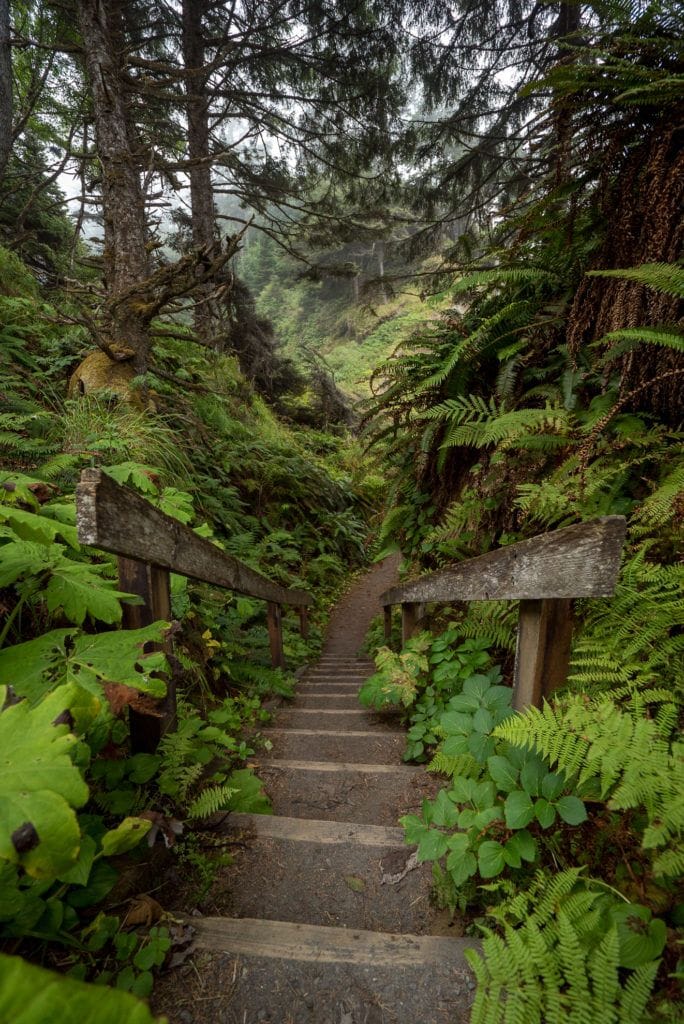
If you want something more challenging with epic views, tackle the ~2,000 foot gain to the top of Mt. Storm King.

Continuing on along HWY 101, don’t miss the Salmon Cascades and the Ancient Grove trail on Sol Duc Hot Spring Rd. If you are traveling during the salmon spawn (varies with temperature changes but generally is September-November), the salmon cascading along the Sol Duc River are a must-see. You can find them halfway down the road to Sol Duc Hot Springs Resort. Just down from the Salmon Cascades viewpoint is also the Ancient Groves 0.6 mile self-guided nature trail loop through an old-growth forest which is a nice quickie for stretching your legs!
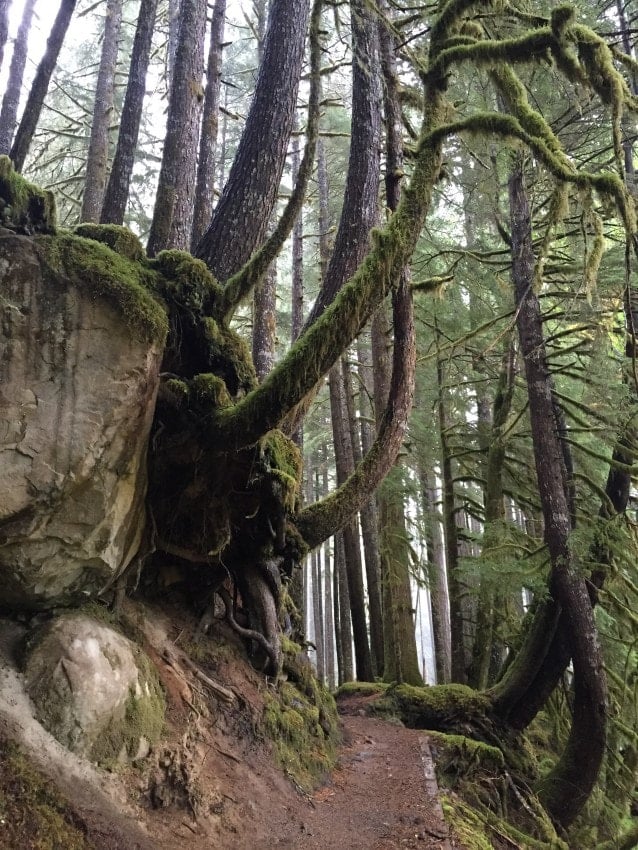
Now, for Sol Duc hot springs…I hate to be negative but these are not wild hot springs that you hike to for a few miles for a quiet soak in nature. Instead, this is a fee-based “hot springs resort” where the naturally flowing water has been piped into concrete and tile soaking tubs. We walked in and checked out the set-up and opted against it. The resort itself includes cabins, massage therapists, food options, and a gift shop.
Since we only had 6 days for our Olympic National Park itinerary, we continued on and ended up camping at Klahowya campground, which is technically outside of the National Park in the neighboring National Forest. It was right along Highway 101 and also along the Sol Duc River. This is a great campsite for putting yourself close to Forks for the next day of adventures!
Day 3: Forks & La Push Beaches
From Klahowya Campground, continue west on your Olympic National Park road trip on Highway 101 towards Forks. If you are a young female, or avid vampire fan, you might be wondering why you’ve heard of Forks, WA. Well, that is the town Stephanie Meyer used to base her Twilight series novels. While none of the movie was filmed on the Olympic Peninsula (Meyer never even visited!), if you do want to “Twilight geek out” head straight to the Forks Chamber of Commerce Visitor Center, which offers all the Twilight trivia and maps you need. It is important to note though that after Port Angeles, Forks is the 2nd largest city you will pass through on this trip so if you need a hot shower, warm bed, more supplies or just a nice cup of espresso, make it happen in Forks!
Just north of Forks is the turn-off for La Push, Mora, and Rialto Beach. La Push has three main beaches and they are simply named – First Beach, Second Beach and Third Beach.
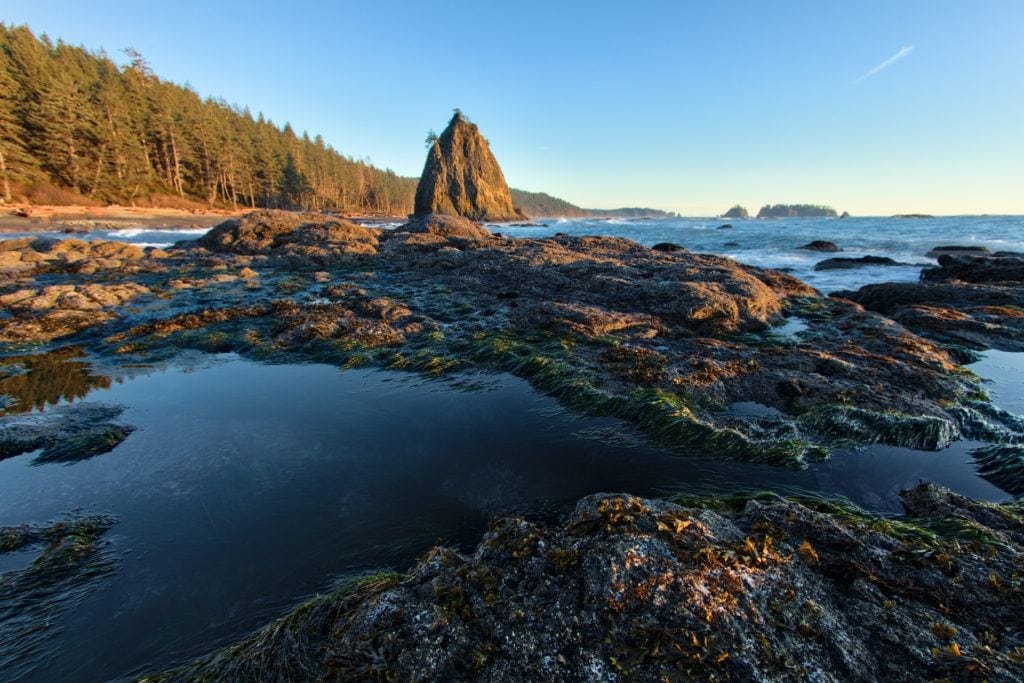
First Beach is literally right in town and is the only beach that can be accessed by car.
Second Beach was roughly a one-mile hike from the parking lot and was an absolutely beautiful spot for a picnic lunch. We ate and explored the large beach before high tide started setting in.
Third Beach is a flat 1.6 mile hike from the parking lot. On the way back to the 101, we did find what appeared to be a cute gem called Manitou Lodge if you need a night in a bed. The lodge is off Mora Road and has a small gift shop that features local artists, which is why we ventured back to check it out. The lodge and its grounds were impressive, and they have lots of information and advice for exploring the local area available in their “Great Room” which boasts a massive stone fireplace and vaulted ceilings. From here, either stay the night at Mora campground or venture on to the Hoh Rainforest to camp.
Day 4: Hoh Rainforest
Before leaving Forks for The Hoh Rainforest, make sure you are stocked on food and necessities, as there is only a small coffee shop/café/convenience store that offers a limited selection. The rainforest, less than an hour from Forks, is located down Upper Hoh Road. Hook a left off 101 onto Upper Hoh Road and travel 18 lush miles east to the Hoh rainforest and visitor center.
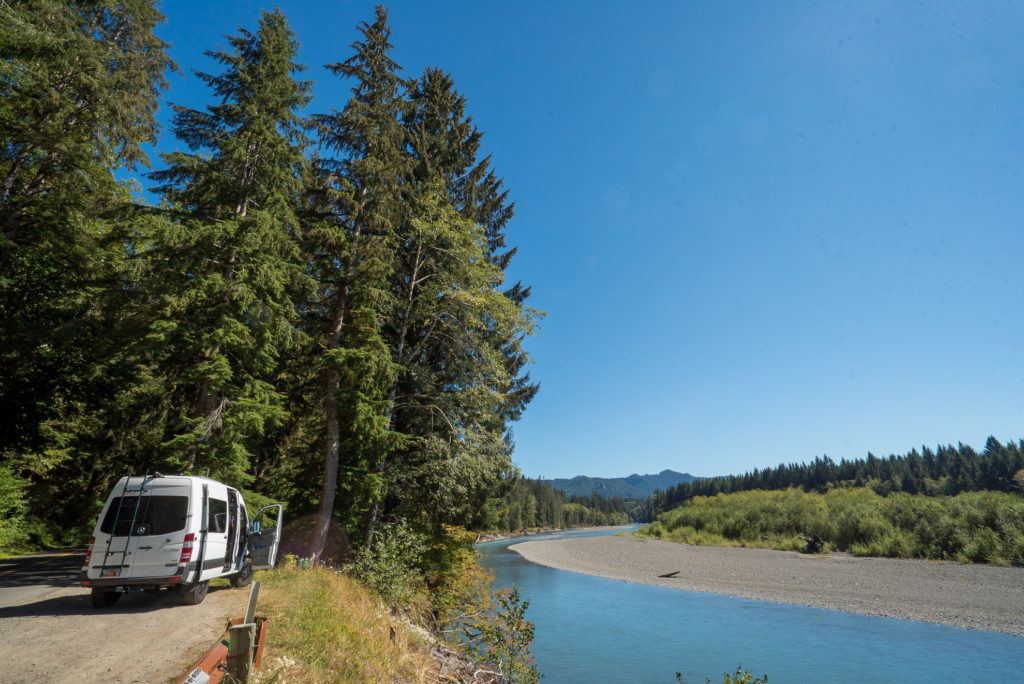
Hoh is the gateway to Mount Olympus. Crazy to think you would hike through a rainforest to get to the tallest peak in the national park! We meandered through the Hall of Mosses trail (0.8 mile loop) as well as the Spruce Nature Trail (1.2 mile loop) both of which I wouldn’t miss. The Spruce Nature trail takes you along the Hoh River where you can see the silt flowing down from the mountains.
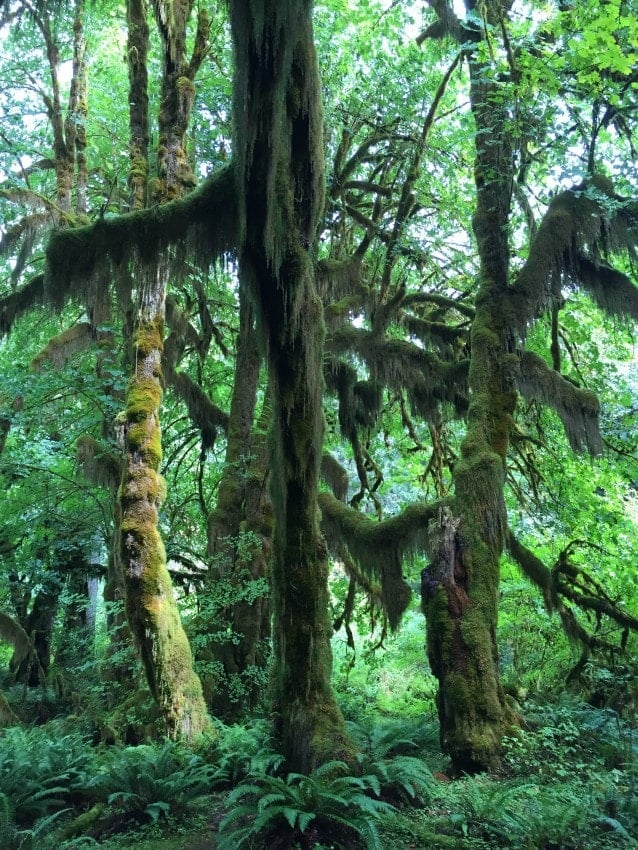
Day 5: Ruby Beach, Kalaloch Beach, and Lake Quinault
On the last day, head to Ruby Beach – apparently the most photographed beach in all of the Olympic Peninsula.
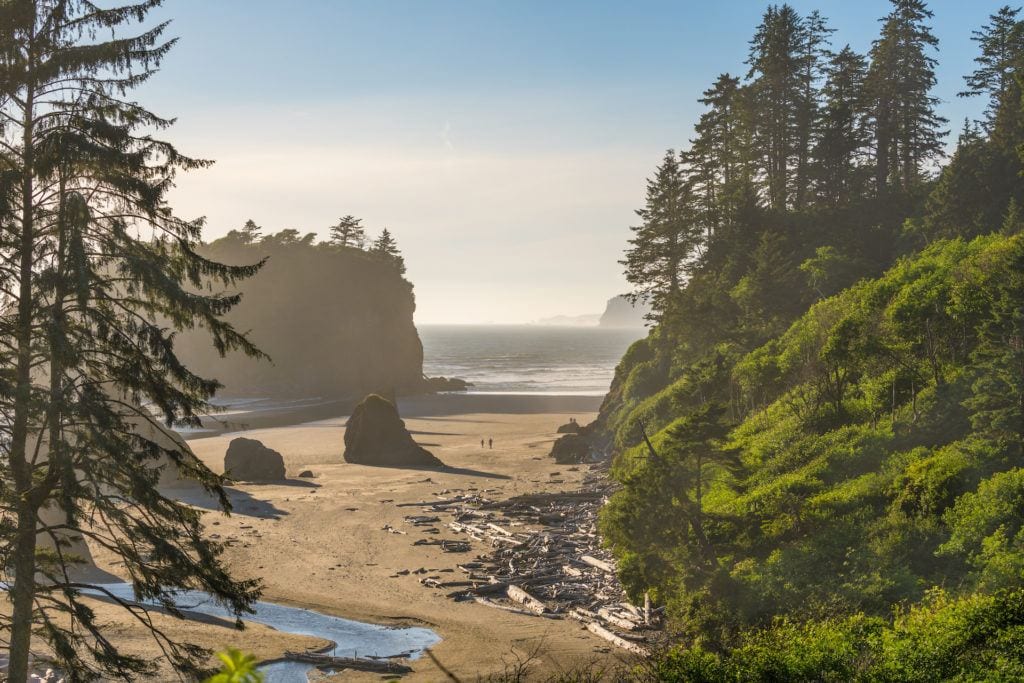
From Ruby Beach we headed down the 101 south to the Kalaloch Lodge. Stop at Beach 4, 3, 2 or 1, which are right off the road, and enjoy the views off of the highway along the way.
Kalaloch Lodge offers seaside cabins, a restaurant, a gift shop and a little convenience store. The gift shop had different goods in comparison to Hurricane Ridge, with a big selection of local products. From Kalaloch Beach continue Lake Quinault where we camped for the night at Willaby campground on a ledge above the lake.
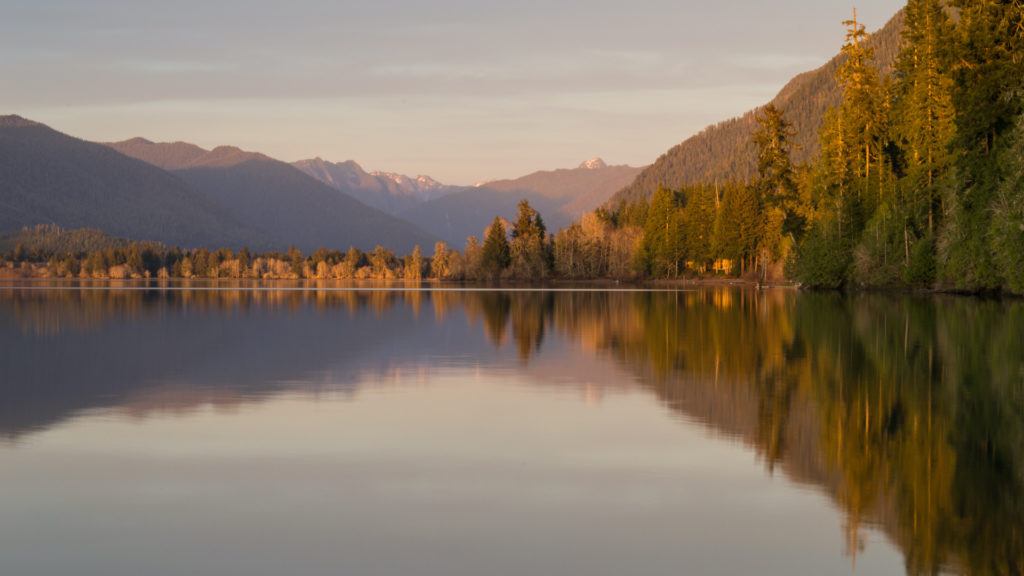
I am a sucker for National Park hotels and the nearby Lake Quinault Lodge is definitely one to checkout. The lodge has Wi-Fi in the public areas and also offers showers (for a fee) for campers. They have a great “living room” complete with vintage photographs of the lodge and memorabilia.
Also don’t miss The Salmon House Restaurant & Lodge. It is a local hangout and has reasonable prices. Their wine glasses hold about half a bottle and the onion rings will not disappoint (and yes, that is what I had for dinner, in case you were wondering). We explored some of the United States Forest Service trails here, which were pleasant but not as surreal as the National Park. The United States Forest Service has an outstanding ranger station and information center right next door to the Lake Quinault Lodge.
Lake Quinault was the last stop on our trip. Afterwards, we made our way back to Seattle via Olympia, a drive that takes just under 4 hours.
Have more time to explore or want to get into the backcountry? There is no question about it…next time I visit Olympic NP I am going to hike the 17.3 mile trail to Glacier Meadows and then another 0.9 miles to see Blue Glacier.
Essential Gear for your Olympic National Park Road Trip
Having solid rain gear for your Olympic National Park itinerary – including proper clothing, a tent with a rainfly (if camping), and warm clothes for nighttime – is critical. Here are a few of the things I brought along and recommend.
Non-cotton layers: Avoid cotton which stays cold and soggy, and instead stick to wool, silk, and synthetic fibers that keep you warm even when wet! Check out Bearfoot Theory’s guide on the Best Hiking Clothes for recommendations.
Raingear: It’s critical that your rain gear (jacket and pants) can hold up in a downpour and also offer protection from the wind. In addition, you’ll want to bring a rain cover for your pack. Check out Bearfoot Theory’s favorite lightweight Rain Jackets for hiking here.
Shoes: Depending what kind of hiking you are doing, you’ll either want a comfy pair or two of trail shoes that you can wear in the car, around camp, and on well maintained trails. I recommend waterproof shoes. Check out some suggestions for hiking shoes here.
A good hat: Even though it might be cloudy, sun protection is important! A brimmed hat will also keep the rain off of your head and face, making it easier to see in wet conditions.
Wool hat, scarf, and gloves to stay warm for the cool nights and mornings
There you have it, a full 5-day loop featuring some of the best highlights of an Olympic National Park road trip and the greater Olympic Peninsula.


Skipping the Hot Springs? That’s crazy talk. I’m from Port Angeles and we go just for that. Would never sit in the gross natural ones. The water IS from the local hot springs, just in clean pool that is naturally cleaned using “resting periods” for a hour during different parts oft he day.
Definitely missed out on the best part of Lake Crescent Lodge as well. On nice sunny days, you can buy a drink at the bar in the lodge and take it out onto the dock or the beach. Just return the glass when done. It’s lovely!
Thanks for the feedback Adrienne!
What did you do on Day 4?? And where did you camp in the Hoh??
And when exactly during the summer did you go?
I’ve enjoyed reading about your trip and will certainly be modeling mine after it!
Thanks Tyler for your comments! On Day 4 we relaxed and did some planning for the rest of our trip home (we were driving from California). We camped at Bogachiel State Park just outside of Forks on the way to Hoh. There are a few campgrounds closer to Hoh but we were nervous they might be full so we grabbed a site at Bogachiel State Park. I went the last week in August.
Thanks for posting such an informative review of Olympic NP. Extremely helpful.
Thanks for the compliment Jeff! We are glad you stopped by! Have an awesome summer.
Hi, First thank you for all the information! I am heading to peninsula in about a month and am doing about what you did with the exception of going to be going to Blue Glacier. Having trouble with deciding on what to pack. Any tips on what you did pack and maybe what you would have not brought or wished you had? Thank you. Tabby
Tabby, I just looked up Blue Glacier and now I am definitely 100% going to have to head back to Olympic. You’ll definitely have to let me know how it is! Great question about packing. I wish I would have had warmer clothes as well as maybe a few additional layers that perform well with rain. We used the car heater to dry some of our clothing between stops. We were pretty wet for about a straight week. Post trip I bought a new raincoat as I realized the protective layer on my jacket had worn off. I’d definitely pack extra dry socks too!
Hi Kim,
Thank you for your post. It’s super helpful. We’re planning our trip for the summer, but I know we have a lot to prepare. We’re going with our kids ages 10 and 9. We’re thinking to camp out in one spot and drive to the other spots in different days so it can be easier on the kiddos. Where do you recommend we should camp?
Thank you!
The kids are going to LOVE the park! The park is pretty spread out to do something like that. I would maybe look at Fairholme. You might need to do two nights on the East side and then two nights over on the West side. Fairholme is the most centered campground for the park.
Hi Kim!
Thank you for posting your report on the trip. We are in beginning stages of planning our vacation in Olympic National Park in the beginning of Aug and it’s so helpful to read your itinerary! We will have 6 days, including a day of coming into park from Seattle and leaving the park for Portland. We were wondering about the same thing that Judy mentioned in her question, whether it’s a good idea to camp in one place and drive to different locations for hikes. From your reply I understand that it might not be a practical idea. But if we were to follow you advice about camping 2-3 nights on East side and 2-3 nights on the West, where would you recommend we stay and do you think it’s a good idea or it’s better to camp in a new place every day? My concern is how hard it will be to find available campgrounds during high season time.
Thank you!
Maia
Hi Maia, thanks so much for reaching out! That is awesome to hear you are heading to Olympic. Personally, I would move nightly but that is just me–I like to go, go, go when I travel so if that’s not something you think you’d enjoy or it sounds stressful then correct, I would recommend doing 2-3 nights on two different sides of the park. Remember you can make reservations for Sol Duc & Kalaloch (I highly recommend BOTH!)
Thanks for all the great ideas of places to stop in Olympic. The choices are overwhelming seem shard to choose sitting at home on my laptop. Going to be there in Mid September and thinking of going WITHOUT reservations for camp sites – ever risked it before but with everything so spread out and so many options it seems doable. Did you ever get turned away or pass a campground that was full? Thanks for all the help!
Loved reading your itinerary! It’s my dream to visit and spend about the same ammount of time in the park with our 4 kids. I’m starting to plan for August 2019. I was wondering, what did you do for food? Did you bring everything with? Were you able to get things like fresh fruits and vegetables on the road?
Thanks!
Hi There! I flew into Seattle so I didn’t take any food with me at all. There are incredibe small grocery local grocery stores in Olympic that had lots of great food. And yes, we found plenty of veggies & fruit.
Excellent blog on the park and the experience. The photos are great also.
Hi, If you are not with campers, do you have suggestions on where to stay at each site or stoping area?
Thanks Krista
Hi Krista, there are numerous little B&B’s in the area as well as lots of great AirBnB listings. There are a few hotels as well.
I did a trip like this that was a recreation of the Press Expedition. It was phenomenal. That and my trip underground Seattle were two of my favorite things.
I enjoyed the picture of Lake Quinault and how the orange and pink sunset reflects on the water. My son and his wife are wanting to visit Olympic National Park for their 10th wedding anniversary in September. It’d be nice if they could find lodging near Lake Quinault to enjoy a similar view.
Downtown Oly has a lot of nice spots to have lunch (oyster house, rambling jacks, fishtake brewpub…)and a Trader Joe’s right off the freeway (101) to stock up on yummy goodies. The hike along “wild beaches” starting near la push is phenomenal as is ShiShi beach. The blue glacier is spectacular in summer but less crowded and with bugleing elk in October. Glad you enjoyed our beautiful peninsula. ❤️
Thank you so much for sharing this great itinerary!!
Planning my trip based on it and the foodie tips 😀
Planning a trip to Olympic NP next month. we won’t be camping (we’re too old!) but would like to get your recommendations on best short hikes and must sees. Also, can you tell me some good hotels along the way? Thanks!
Hi Brian – this itinerary is actually great for short hikes and must-sees on the Olympic Peninsula. You can pretty much follow it exactly and find great walks and places to stay. We don’t have specific lodging recommendations other than what we wrote about in the post (Lake Crescent Lodge and Kalaloch Lodge). Have a great trip!
The High Divide hiking loop is indeed outstanding. IMHO the trail to the Enchanted Valley, the historic chalet and Anderson Pass is equally great, if one has the time. In Spring, hundreds/thousands of snow-melt water-falls tumble down the steep ice-carved valley walls.
Hi!
Exactly what I was looking for, thank you for the great details! Thinking of staying in Forks (airbnb rental) for 2-3 nights and then going to Port Angeles (2-3 nights). The hope is that we will do beach trips on weekend and do rain forest and hurricane ridge on weekdays. So basically same itinerary, but reverse order. Am I missing anything?
Hi Swetha, we’ve had team members do this trip in both directions & the order doesn’t matter – it’s beautiful both ways. Don’t miss sunset on one of the beaches! And I also recommend checking out the “Tree of Life” near Kalaloch. Enjoy your trip!
I have 6 days but taking 1 to go to Cape Flattery. My dilemma is trying to fit in Ruby Beach and HOH rainforest before heading to Lake Quinault for a 1 night stay.
Day 1 arrive in Seattle 10:30. Drive to Lake Crescent Lodge.
Day 2 Marymere Falls, Sol Doc Falls, drive to Forks check in to hotel
Day 3 Cape Flattery and maybe Shi Shi
Day 4 Rialto Beach and La Push beaches. Check out of Forks hotel
Day 5 HOH and Ruby then drive to Lake Quinault ( I feel like this might be too much?)
Day 6 drive to Seattle
Looking for advice on what I might rearrange or skip? Thanks!
Hi Roxie, I think the Hoh rainforest is really unique & a must-do while in Olympic. The distance from Hoh to Ruby Beach is only 15 minutes and then the lake is about 45 minutes from the beach. I don’t think it’s too much in 1 day, especially since the hiking in the Hoh are shorter hikes. Enjoy your trip!
We did this trip 2 years ago. We veered off your itinerary a bit but it was definitely helpful. Thank you so much. We were so bummed that ruby beach was closed at the time. Everyone should visit ONP at least once in their life time. We made it all the way to Port Angeles and drove home to San Diego on Coast Highway.